A centrosome is an organelle present in eukaryotic cells that serves as the main microtubule organizing center. It is composed of two centrioles, which are cylindrical structures made up of microtubules arranged in a nine-fold symmetry, and a matrix of proteins that surround and support the centrioles.
The centrosome plays a critical role in various cellular processes such as cell division, cell migration, and organization of the cytoskeleton. During cell division, the centrosome duplicates and separates into two poles, which are responsible for organizing and separating the chromosomes. In addition, the centrosome helps in the formation of cilia and flagella, which are essential for cell motility and sensory functions.
The centrosome is found in most animal cells, while some plant cells have a similar organelle called the microtubule organizing center (MTOC). Defects in centrosome function have been associated with various diseases, including cancer, microcephaly, and ciliopathies.
What is Centrosome?
Centrosomes are disc-shaped cellular components that are constructed from microtubule components and play a crucial role in cell division.
- In cell biology, the centrosome is an organelle that acts as the major microtubule organising centre (MTOC) of the animal cell and as a regulator of cell-cycle progression (Latin centrum “centre” + Greek sma “body”). It was formerly known as the cytocentre.
- The centrosome gives the cell its structure. The centrosome is believed to have originated exclusively in eukaryotic cells from the metazoan lineage. Because they lack centrosomes, fungi and plants use other structures to arrange their microtubules.
- Although the centrosome is crucial for effective mitosis in animal cells, some fly and flatworm species do not require them.
- Two centrioles are placed at right angles to one another to form centrosomes, which are encased in a thick, highly structured protein mass known as the pericentriolar material (PCM).
- Proteins including -tubulin, pericentrin, and ninein, which are involved in microtubule nucleation and anchoring, are found in the PCM.
- Centrin, cenexin, and tektin are found in each centriole of the centrosome, which is often built on a nine-triplet microtubule framework combined into a cartwheel structure.
- During cellular development, the centrosome is replaced by a cilium in many different cell types. The centrosome, however, replaces the cilium once the cell begins to divide.
- Walther Flemming and Edouard Van Beneden discovered the centrosome together in 1875 and 1876, respectively. Theodor Boveri later described and gave the structure its name in 1888.
Features of Centrosome
- Two centrioles: The centrosome consists of two centrioles that are perpendicular to each other. Each centriole is made up of microtubules arranged in a nine-fold symmetry.
- Pericentriolar material: The centrioles are surrounded by a matrix of proteins called pericentriolar material (PCM), which contains hundreds of proteins involved in microtubule nucleation and organization.
- Microtubule organizing center: The centrosome is the main microtubule organizing center in eukaryotic cells. It nucleates, organizes, and directs the growth and assembly of microtubules.
- Role in cell division: The centrosome is crucial for cell division, as it organizes the spindle fibers that attach to the chromosomes and separate them during mitosis and meiosis.
- Cilia and flagella formation: The centrosome is involved in the formation of cilia and flagella, which are essential for cell motility and sensory functions. The basal body of cilia and flagella is derived from the centrosome.
- Role in cell polarity and migration: The centrosome helps to establish cell polarity by organizing the cytoskeleton and directing the movement of vesicles and organelles. It also plays a role in cell migration by organizing the microtubules and actin filaments that are required for cell movement.
- Signal transduction: The centrosome functions as a signaling hub, where it can integrate signaling pathways and regulate various cellular processes.
Centrosome Structure
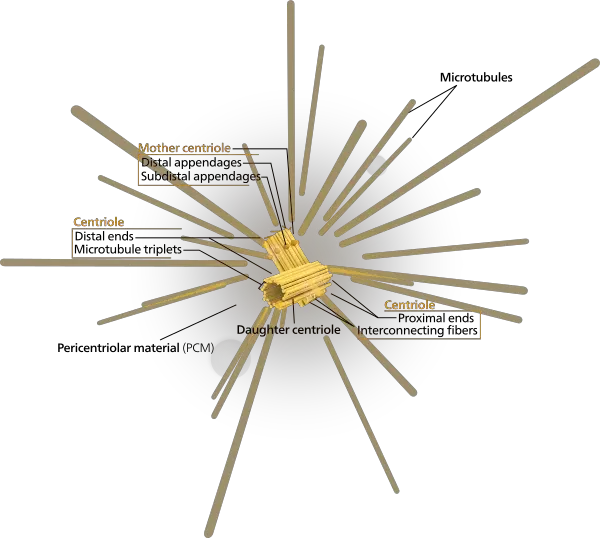
- The main centrosome is often located near to the nucleus so that other microtubule-associated organelles can occupy specific sites throughout the cell. Two centrioles are surrounded and joined by fibres and pericentriolar material to form the centrosome.
- Each centriole is composed of nine microtubule triplets that create a barrel-shaped structure. The two centrioles are parallel to one another. They differ structurally from one another. Distal and subdistal appendages of the mother centriole serve as basal bodies by anchoring the centrioles to the cell membrane.
- During mitotic and meiotic cell division, microtubules emerge from the centrosome to direct vesicle and organelle traffic. The pair of centrioles are joined via the proximal region by a big protein.
- Because the centrioles are derived from the basal bodies, they share their structure. In eukaryotic cells, the centrosome can be spotted using a light microscope; it is surrounded by a protein membrane known as pericentriolar material.
- Many proteins are required for the anchoring, release, and nucleation of centrosome microtubules due to the importance of the centrosome in multiple tasks, such as the organisation of microtubules inside the cell.
- The two centrioles in the centrosome, the mother centriole and the daughter centriole, are functionally and structurally different. Yet, both centrioles contain microtubules that contribute to cell division. At its distal end, the mother centriole is distinguished by the presence of nine appendages grouped in two groups. During ciliogenesis in the plasma membrane of an inset cell, these appendages are necessary for the microtubule anchoring and mother centriole docking.
- The length of the daughter centriole is approximately 80% of the length of the mother centriole. During ciliogenesis, the daughter centriole cannot attach to the plasma membrane because it lacks the nine distal appendages. Moreover, only the mother centriole centres the centrosome.
- The characteristics of the centriole determine the centrosome’s qualities, such as replication, polarity, stability, and dynamic nature. Due to the extreme stability of centrioles, their microtubules are resistant to detergents and cold. This stability is provided by centriole components such as ribbon proteins and tektins, allowing centrioles to survive multiple cell generations.
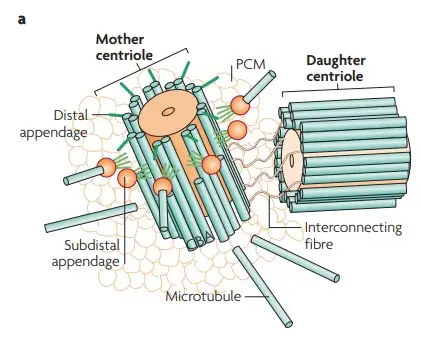
- The centrosome is composed of two perpendicular centrioles, a mother centriole and a daughter centriole, which are interconnected by fibres.
- It is composed of a protein complex that aids in the creation of new microtubules.
- A pericentriolar matrix that is amorphous surrounds the centrioles. It is involved in microtubule nucleation and anchoring in cytoplasm.
- Centrosomes in animal cells are very similar to DNA. During cell division, one centrosome from the parent cell is transmitted to each daughter cell.
- In proliferating cells, the centrosome starts dividing before the S-phase begins. The recently created centrosomes contribute to the organisation of the mitotic spindles.
- During Interphase, the centrosome organises an astral ray of microtubules that contribute in intracellular trafficking, cell adhesion, cell polarity, etc.
- In post-mitotic cells, the centrosome is composed of a mother centriole and a daughter centriole, also known as the mother centriole and daughter centriole, respectively.
The centriole duplication cycle
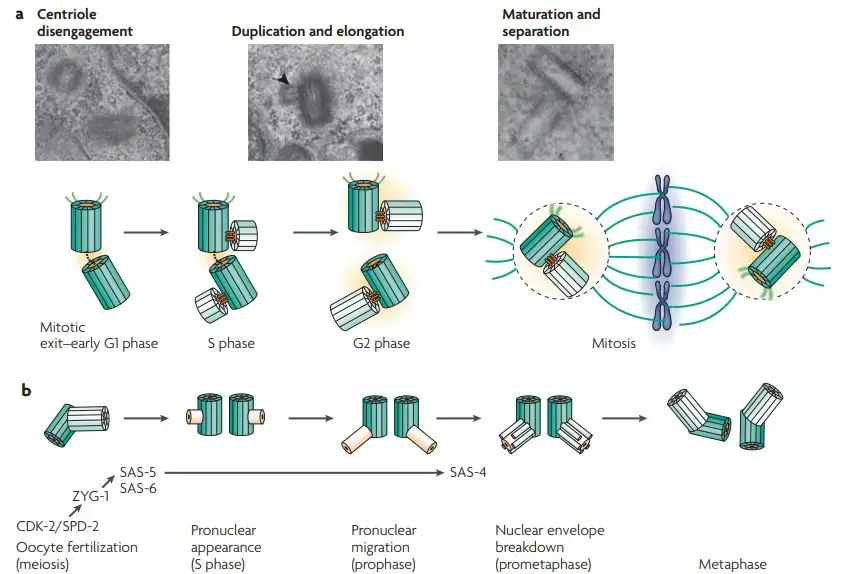
Electron micrographs of HeLa cells illustrating distinct centriole replication steps (also shown diagrammatically). The mother centriole is depicted in dark green with protrusions. Daughter centrioles are depicted in a pale green colour. After mitotic exit–early G1 phase, centrioles in a centrosome loose their orthogonal configuration. At this time, an intercentriole connection may exist. In late G1–S phase, the nucleation of daughter centrioles initiates duplication (see electron micrograph; the arrowhead shows a procentriole). Notice that the axis of the daughter intercepts the parent. By late G2 phase or the start of G1 phase of the subsequent cell cycle, the procentrioles have fully elongated. At the G2–M transition, the two centrosomes mature and separate through the acquisition of maturation markers140, the recruitment of pericentriolar material (PCM; yellow), and an increase in microtubule-organizing centre (MTOC) activity. The centrioles in Caenorhabditis elegans are smaller and simpler than the human ones, showing a central tubule surrounded by 9 singlet microtubules (MTs). Despite changes in the structure, the centriole cycle seems to be regulated in a similar way. In S phase, daughter centrioles (yellow) are also nucleated. These structures are predominantly made up of short core tubules that lengthen throughout the G2 phase and mitosis. Moreover, the centrioles acquire exterior tubules (light green). It has been demonstrated that cyclin-dependent kinase-2 (CDK-2) is essential for the recruitment of spindle-defective protein-2 (SPD-2) to the mother centriole. SPD-2 is essential for ZYG-1 recruitment. ZYG-1 is essential for the recruitment of the complex formed by SAS-5 and SAS-6, which is required for the formation of the inner centriole tube. Later, the development of this tube is crucial for the binding of SAS-4, resulting in the creation of MTs in the surrounding region.
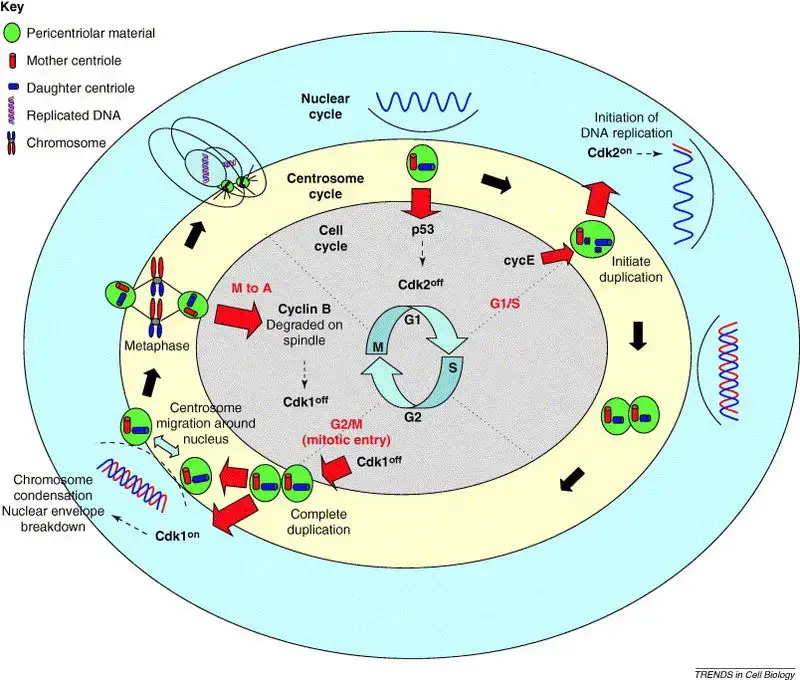
The centrosome generates four distinct types of microtubules based on the direction of their movement and organisation.
- Astral Microtubules: These microtubules are oriented away from the metaphase plate and aid in centrosome orientation during cell division.
- Chromosomal Microtubules: They are connected to the chromosome’s arms and prevent the disruption of chromatids during separation.
- Kinetochore Microtubules: Attached to the kinetochore, they divide sister chromatids during anaphase via opposing pull forces from both sides.
- Polar Microtubules: These microtubules extend to aid in chromosomal separation without being connected to chromosomes.
Centrosome cycle
- The principal microtubule organising centres (MTOC) in mammalian cells are centrosomes. Failure of centrosome control is connected with aneuploidy and can lead to errors in chromosomal segregation.
- A centrosome consists of two orthogonal cylinder-shaped protein assemblies known as centrioles, which are surrounded by a protein-rich amorphous cloud of pericentriolar material (PCM). The PCM is necessary for microtubule nucleation and structure.
- The centrosome cycle is crucial for ensuring that daughter cells obtain centrosomes following cell division. The centrosome undergoes a variety of structural and functional changes as the cell cycle develops. The centrosome cycle is initiated early in the cell cycle such that there are two centrosomes by the time mitosis occurs.
- Since the centrosome organises a cell’s microtubules, it is involved in the creation of the mitotic spindle, polarity, and hence cell shape, as well as many other mitotic spindle-related functions.
- The centriole is the innermost component of the centrosome, and its usual structure resembles that of spokes on a wheel. Different creatures have somewhat varied conformations, but its overall structure is similar. In contrast, plants do not often have centrioles.
- The centrosome cycle consists of four synchronised phases with the cell cycle. They consist of centrosome duplication during the G1 and S phases, centrosome maturation during the G2 phase, centrosome separation during the mitotic phase, and centrosome disorientation during the late mitotic phase—G1 phase.
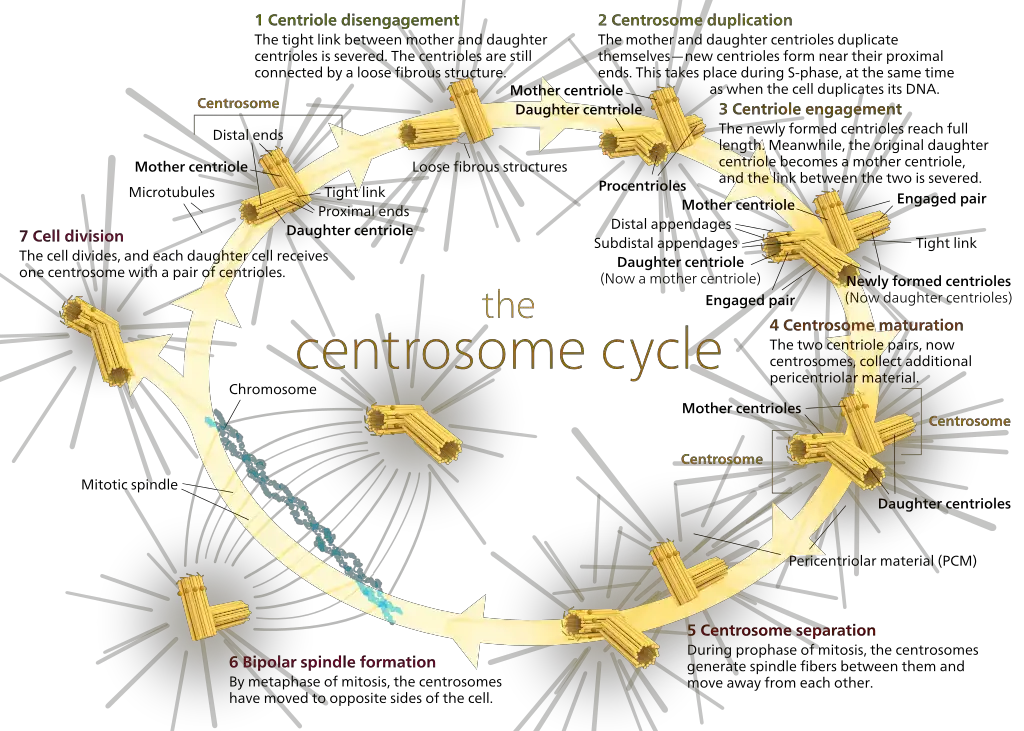
1. Centriole synthesis
- New daughter cells generate centrioles by duplicating preexisting centrioles in the mother cells. As a result of cell division, each daughter cell inherits two centrioles (one centrosome) surrounded by pericentriolar material. However, the ages of the two centrioles differ.
- During the cell cycle, one centriole originates from the mother cell and the other is replicated from the mother centriole. Because the mother and daughter centrioles differ in both shape and function, it is possible to distinguish between the two preexisting centrioles.
- The mother centriole, for instance, can nucleate and organise microtubules, while the daughter centriole can only nucleate.
- As the cell transitions from the G1 phase to the S phase, procentrioles first form adjacent to each existing centriole.
- During the S and G2 phases of the cell cycle, procentrioles grow until they reach the same length as the mother and daughter centrioles. At this point, the daughter centriole assumes the characteristics of its mother.
- When the new centriole and its mother centriole reach their full length, they form a diplosome. Aiding mitosis, a diplosome is a rigid complex formed by an orthogonal mother and newly formed centriole (now a daughter centriole).
- During mitosis, the distance between the mother and daughter centrioles grows until, in conjunction with anaphase, the diplosome disassembles and each centriole is surrounded by its own pericentriolar material.
2. Centrosome duplication (Cell cycle regulation of centrosome duplication)
- The replication of centrosomes is intended to occur only once every cell cycle and is consequently tightly regulated.
- Several factors have been revealed to regulate the centrosome cycle, including reversible phosphorylation and proteolysis.
- In addition, it undergoes distinct processes at each stage of cell division as a result of stringent regulation, which makes the process so efficient.
- Cell cycle regulations substantially influence centrosome duplication. cyclin-dependent kinase 2 mediates this connection between the cell cycle and centrosome cycle (Cdk2). The protein kinase Cdk2 is known to regulate the cell cycle.
- There is abundant evidence that Cdk2 is required for DNA replication and centrosome duplication, both of which are crucial events in S phase.
- Furthermore, it has been demonstrated that Cdk2 forms complexes with both cyclin A and cyclin E, and that this complex is essential for centrosome duplication. It has been postulated that three Cdk2 substrates regulate centriole duplication: nucleophosmin (NPM/B23), CP110, and MPS1.
- The phosphorylation of nucleophosmin by Cdk2/cyclin E removes nucleophosmin from centrosomes, hence starting the creation of centrioles. CP110 is a crucial centrosomal protein that is phosphorylated by both interphase and mitotic Cdk/cyclin complexes and is believed to regulate centrosome duplication during the S phase.
- MPS1 is a protein kinase that is crucial to the spindle assembly checkpoint. It is believed to transform an SAS6-cored intermediate between severed mother and daughter centrioles into a pair of cartwheel protein complexes on which procentrioles assemble.
3. Centrosome maturation
- Centrosome maturation is characterised by the accumulation or growth of -tubulin ring complexes and other PCM proteins at the centrosome.
- This increase in -tubulin enhances the centrosome’s ability to nucleate microtubules as it matures. It is believed that Polo-like kinases (Plks) and Aurora kinases are responsible for phosphorylation during centrosome development, which plays a crucial regulatory role.
- The phosphorylation of Plks and Aurora A’s downstream targets causes the recruitment of -tubulin and other proteins that form the PCM around the centrioles.
4. Centrosome separation
- Many motor proteins induce centrosome separation in early mitosis. At the beginning of prophase, the motor protein dynein generates the majority of the force necessary to separate the two centrosomes.
- The real separation event occurs at the G2/M transition and occurs in two stages. The connection between the two parental centrioles is severed in the first phase. In the second step, microtubule motor proteins separate the centrosomes.
5. Centrosome disorientation
- Loss of orthogonality between the mother and daughter centrioles is referred to as centrosome disorientation.
- The mature centriole begins to travel towards the split furrow once it becomes disoriented. It has been hypothesised that this motion is a crucial component in abscission, the final phase of cell division.
6. Centrosome reduction
- Centrosome reduction is the slow loss of centrosomal components that occurs following mitosis and throughout differentiation.
- In dividing cells, the centrosome has lost the majority of its pericentriolar material (PCM) and microtubule nucleation capacity following mitosis. In addition to the loss of PCM and its microtubule nucleation capacity, the structure of sperm centrioles is altered.
7. Dysregulation of the centrosome cycle
- Incorrect passage through the centrosome cycle can result in erroneous centrosome counts and aneuploidy, which may eventually lead to cancer.
- Uncertain is the involvement of centrosomes in tumour progression. Incorrect expression of genes such as p53, BRCA1, Mdm2, Aurora-A, and survivin increases the number of centrosomes in a cell.
- However, it is unclear how these genes affect the centrosome or how an increase in centrosomes affects tumour growth.
Controversy Over Necessity
- Several years ago, it was believed that animal cells could not divide without centrosomes to coordinate the separation of sister chromatids, cytoskeleton modifications, etc. Several cells in the laboratory were shown to cease dividing or to divide wrongly when their centrosomes were removed, supporting this notion.
- In recent years, however, it has been discovered that some animal species can develop normally despite being genetic mutants that lack centrosomes. Fruit flies and flatworms are among the organisms that successfully divide their cells without centrosomes.
- This has generated doubts regarding the true value of centrosomes and if the cell can “compensate” for their loss through other methods. Some scientists hypothesise that centrosomes may facilitate the processes described in this article, but are not essential to them.
- Additional data is needed before scientists can determine for sure if centrosomes are crucial to cell division, and what they can achieve that cells don’t have other ways to accomplish. But for the time being, it is more prudent to presume that they are significant than that they are not!
In the past, it was believed that animal cells could not divide without centrosomes, which coordinate the separation of sister chromatids and other processes. Recent studies, however, have shown that some animals, such as fruit flies and flatworms, can develop normally without centrosomes. This has led to uncertainty about the true importance of centrosomes, and some scientists believe that they may facilitate cellular processes but are not essential to them. However, more research is needed to determine the exact role of centrosomes in cell division, and until then, it is best to assume that they are significant.
Centrosome in Animal Cells
- The centrosome is a tiny organelle situated close to the nucleus in animal cells. It is made up of two perpendicular centrioles and pericentriolar material (PCM), which comprises hundreds of proteins involved in microtubule nucleation and organisation.
- During mitosis or meiosis, the centrosome performs an essential function in arranging the spindle fibres that bind to the chromosomes and pull them apart. During the cell cycle, centrosomes replicate, and the duplicated centrosomes travel to opposing poles of the cell to produce the two spindle poles.
- In addition to creating cell polarity, the centrosome is responsible for structuring the cytoskeleton and controlling the movement of organelles and vesicles. It contributes to the production of cilia and flagella, which are essential for cell movement and sensory capabilities.
- Several diseases, such as cancer, developmental disorders, and neurodegenerative diseases, have been linked to dysfunctional centrosomes. Hence, the centrosome is an essential organelle in animal cells, as it plays a crucial role in cell division, cell polarity, and cellular structuring.
Centrosome in Plant Cells
- Without centrosomes, plants and fungus utilise MTOC structures to organise their microtubules. Plant cells lack spindle pole bodies and centrioles with the exception of a few blooming plants’ flagellate male gametes, which include both structures (conifers).
- During mitosis of the plant cell, the nuclear envelope appears to assume the principal function of the MTOC, which is spindle organisation and microtubule nucleation.
- Higher plants have created an uncommon mechanism to regulate the dynamics and assembly of the cytoskeleton. In numerous other organisms committed to establishing polarity, microtubules are nucleated at the organising and nucleation centres.
- Plants lack centrosome-like organelles but are capable of constructing spindles; thus, they have evolved cytoskeletal arrays such as the preprophase band, the cortical arrays, and the phragmoplast that are involved in essential growth processes.
- Some components, such as gamma-tubulin, play a significant role in microtubule nucleation near the surface of the nucleus, which is referred to as the principal active microtubule-organizing centre in plants.
Centrosome and Diseases
- Since the centrosome is heavily involved in cell cycle regulation, it is anticipated that it plays a role in carcinogenesis. In practically all human tumours, including liver, breast, bone marrow, colon, prostate, and cervical cancer, the number, structure, and size of the centrosome are aberrant.
- Centrosome amplification is caused by the depletion of tumor-suppressor protein (Rb) in animals, as well as the BRCA1 breast cancer gene defect. Centrosome amplification may also be caused by aurora A overexpression and other kinases involved in the evolution of cancer.
- The amplification of the centrosome may be caused by errors in cytokinesis or dysregulation in the replication machinery, which may result in chromosome instability.
- In cancer, centrosomal amplification causes problems in cilia signaling, altered microtubule activity, lagging chromosomes, and asymmetric cell division, all of which result in overproliferation.
Functions of Centrosome
- Microtubule organization: The centrosome is the main microtubule organizing center in eukaryotic cells. It nucleates, organizes, and directs the growth and assembly of microtubules, which form the basis of the cytoskeleton.
- Cell division: The centrosome plays a vital role in cell division, as it is responsible for organizing the spindle fibers that attach to the chromosomes and separate them during mitosis and meiosis. The duplicated centrosomes move to opposite poles of the cell, forming the two spindle poles.
- Cilia and flagella formation: The centrosome is involved in the formation of cilia and flagella, which are essential for cell motility and sensory functions. The basal body of cilia and flagella is derived from the centrosome.
- Cell polarity and migration: The centrosome helps to establish cell polarity by organizing the cytoskeleton and directing the movement of vesicles and organelles. It also plays a role in cell migration by organizing the microtubules and actin filaments that are required for cell movement.
- Signal transduction: The centrosome has been shown to function as a signaling hub, where it can integrate signaling pathways and regulate various cellular processes, including cell division and differentiation.
- DNA damage response: The centrosome has been shown to play a role in the DNA damage response by recruiting DNA repair proteins to sites of DNA damage.
Defects in centrosome function have been linked to several diseases, including cancer, microcephaly, and ciliopathies, underscoring the importance of this organelle in cellular physiology.
FAQ
What is a centrosome?
A centrosome is an organelle found in animal cells that consists of a pair of centrioles surrounded by pericentriolar material (PCM).
What is the function of the centrosome?
The centrosome plays a crucial role in organizing the spindle fibers that attach to the chromosomes and pull them apart during cell division. It also helps to establish cell polarity and is involved in the formation of cilia and flagella.
What happens if the centrosome is defective?
Defects in centrosome function can lead to errors in chromosome segregation during cell division, resulting in aneuploidy, a condition in which cells have an abnormal number of chromosomes. Aneuploidy is a hallmark of cancer and other diseases.
Are there different types of centrosomes?
There is only one type of centrosome in animal cells, but there are variations in composition and function across different cell types and developmental stages.
How does the centrosome contribute to cell polarity?
The centrosome helps to establish cell polarity by organizing the cytoskeleton and directing the movement of organelles and vesicles.
How does the centrosome contribute to the formation of cilia and flagella?
The centrosome is involved in the formation of cilia and flagella by organizing the microtubules that make up these structures.
Can animal cells divide without a centrosome?
Some animal species can develop normally despite being genetic mutants that lack centrosomes. Fruit flies and flatworms are among the organisms that successfully divide their cells without centrosomes.
How does the centrosome contribute to maintaining genomic stability?
The centrosome plays a crucial role in ensuring the fidelity of chromosome segregation during cell division, which is essential for maintaining genomic stability.
Can defects in centrosome function lead to diseases other than cancer?
Yes, defects in centrosome function have been linked to developmental disorders and neurodegenerative diseases.
Is the centrosome unique to animal cells?
Yes, the centrosome is unique to animal cells and is not found in plant or bacterial cells.
References
- Bettencourt-Dias, M., Glover, D. Centrosome biogenesis and function: centrosomics brings new understanding. Nat Rev Mol Cell Biol 8, 451–463 (2007). https://doi.org/10.1038/nrm2180
- Bornens M. The centrosome in cells and organisms. Science. 2012 Jan 27;335(6067):422-6. doi: 10.1126/science.1209037. PMID: 22282802.
- https://www.biologyonline.com/dictionary/centrosome
- https://royalsociety.org/blog/2020/02/focus-on-centrosome-biology/
- https://cshperspectives.cshlp.org/content/7/2/a015800
- https://study.com/academy/lesson/centrosome-definition-function-quiz.html
- https://www.aakash.ac.in/important-concepts/biology/centrosome-and-centriole
- https://biologydictionary.net/centrosome/
- https://www.sciencedirect.com/topics/neuroscience/centrosome
- https://www.sciencedirect.com/topics/biochemistry-genetics-and-molecular-biology/centrosome
- https://www.genome.gov/genetics-glossary/Centrosome#:~:text=A%20centrosome%20is%20a%20cellular,opposite%20ends%20of%20the%20cell.
- Text Highlighting: Select any text in the post content to highlight it
- Text Annotation: Select text and add comments with annotations
- Comment Management: Edit or delete your own comments
- Highlight Management: Remove your own highlights
How to use: Simply select any text in the post content above, and you'll see annotation options. Login here or create an account to get started.